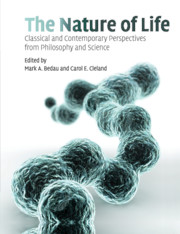Book contents
- Frontmatter
- Contents
- Preface
- Acknowledgments
- Sources
- About the authors
- Introduction
- SECTION I CLASSICAL DISCUSSIONS OF LIFE
- SECTION II THE ORIGIN AND EXTENT OF NATURAL LIFE
- SECTION III ARTIFICIAL LIFE AND SYNTHETIC BIOLOGY
- 16 Learning from functionalism: prospects for strong artificial life
- 17 Life, “artificial life,” and scientific explanation
- 18 Alien life: how would we know?
- 19 Automatic design and manufacture of robotic life forms
- 20 A giant step towards artificial life?
- 21 Approaches to semi-synthetic minimal cells: a review
- 22 Creating “real life”
- SECTION IV DEFINING AND EXPLAINING LIFE
- Supplementary bibliography on life
- Index
- References
18 - Alien life: how would we know?
Published online by Cambridge University Press: 10 November 2010
- Frontmatter
- Contents
- Preface
- Acknowledgments
- Sources
- About the authors
- Introduction
- SECTION I CLASSICAL DISCUSSIONS OF LIFE
- SECTION II THE ORIGIN AND EXTENT OF NATURAL LIFE
- SECTION III ARTIFICIAL LIFE AND SYNTHETIC BIOLOGY
- 16 Learning from functionalism: prospects for strong artificial life
- 17 Life, “artificial life,” and scientific explanation
- 18 Alien life: how would we know?
- 19 Automatic design and manufacture of robotic life forms
- 20 A giant step towards artificial life?
- 21 Approaches to semi-synthetic minimal cells: a review
- 22 Creating “real life”
- SECTION IV DEFINING AND EXPLAINING LIFE
- Supplementary bibliography on life
- Index
- References
Summary
INTRODUCTION
To recognize alien life, we would need to know what we mean by alien, and what we mean by life. Let us take the first thing first. We would see life as alien, I suggest, if it were discovered on a different planet, if it involved a fundamentally different biochemistry on planet Earth or if it was artificially generated by artificial intelligence/artificial life (AI/A-life) research (robots, perhaps?).
In particular, we would see it as alien if it consisted of purely virtual organisms: creatures existing only in computer memory, and manifested on the VDU screen. Most talk about life, alien or otherwise, assumes some physical object (some “body”)—perhaps microscopically small—existing as a material thing. But this is not applicable to purely virtual organisms. The claim that such cyber-creatures could properly be regarded as alive is the claim that “strong A-life” is possible. (Strong A-life is so-called by analogy with strong AI (Searle 1980).) And that claim cannot be assessed without considering what, in general, we would count as life.
That is a notoriously difficult question. In this paper, I will concentrate on one of the commonly listed criteria of life: metabolism. As we shall see, metabolism (in the sense used by biologists) is a form of biochemical fine-tuning. It characterizes all known life, as a matter of fact—and, I will argue, as a matter of necessity too. If that is right, then something that does not metabolize cannot properly be regarded as being alive.
- Type
- Chapter
- Information
- The Nature of LifeClassical and Contemporary Perspectives from Philosophy and Science, pp. 249 - 259Publisher: Cambridge University PressPrint publication year: 2010
References
- 1
- Cited by



